Begonias: A Brief Overview
Begonia is the fifth largest genus of flowering plants, with over 1,800 species and hybrids. They are known by their bright, full flowers and also their leaves, which vary to showcase patterns, designs, or color (Figure 1). Begonias have a pantropical distribution, occupying the tropical regions of every continent except Australia, and are commonly used in the landscape, although in Florida their heat tolerance makes them more desirable as a potted plant or houseplant. They thrive best in partially shaded areas because they are sensitive to bright light and should be protected from the Florida summers in particular. Begonias grow in USDA Hardiness Zones 3–11 and are often used in hanging baskets, flowerpots, and garden beds as well as in the landscape (Gardening Solutions 2019). This EDIS publication is for Florida gardeners and horticulturalists hoping to learn more about the different classifications of begonias, as well as for those interested in learning more about this potential landscape or houseplant.

Credit: Matthew Creech, UF/IFAS
Classification and Diversity
Begoniaceae falls under the order Cucurbitales, which also includes the valuable family Cucurbitaceae (i.e., pumpkin, zucchini, squash, and other gourds) as well as other small plant families. Begoniaceae is broken down into two genera: Begonia and Hillebrandia. Horticulturalists and botanists group plants into concise categories, which has proven difficult in begonias due to their ability to easily produce hybrids. Today's commercially grown begonias are mostly hybrids between wild types collected around the world.
However, following standards established by the American Begonia Society, begonias can be separated into three main categories: fibrous-rooted, rhizomatous, and tuberous begonias. Due to their diversity and the abundance of hybrids, classifying begonias can be quite the challenge.
Fibrous-Rooted Begonias
Fibrous-rooted begonias can be further divided into wax, or bedding, begonias and include cane-like, shrub, trailing, and thick-stemmed begonias. Though all begonias have fibrous roots, this category is used to describe those that have only fibrous roots, as opposed to having rhizomes or tubers also. These plants are most commonly observed as summer bedding plants, adding a splash of color to the landscape.
Semperflorens Group
Also known as "wax begonias," these are popular bedding plants with erect stems and glossy round leaves, often green or bronze in color (Figure 2). The flowers are small but numerous, appearing in varying shades of red, pink, and white. They are usually produced from seed and grown as annuals, but one can prolong their life with proper care and by moving them indoors in the fall and winter.
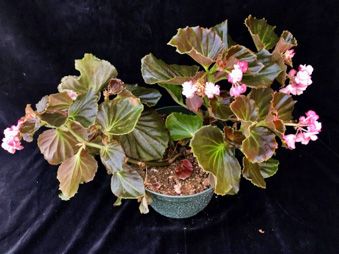
Credit: Julian Ginori, UF/IFAS
Cane-like Begonias
Cane-like begonias often have erect stems resembling bamboo, which is where they get their name. Cane begonias are known for their highly asymmetric, pointy, wing-shaped leaves, although there are many exceptions (Figure 3). They are sometimes referred to as "angel wing begonias" and are known for their foliage, which is often shiny, hairy, colorful, or dotted. Flowers are typically small, appearing in red, pink, and white, similar to wax begonias.
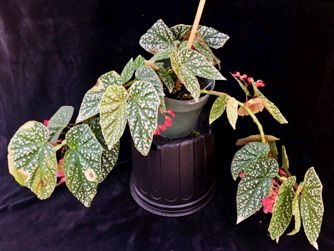
Credit: Julian Ginori, UF/IFAS
Shrub Begonias
Plants that fall into this grouping are known for producing many shoots that come up from the soil to make a full plant. Shrub begonias are ideal for use as bedding plants (Figure 4). Though not as popular as other types of begonia in the landscape, shrub begonias are very easy to grow and tend to have unique leaves accompanied by mostly white flowers, although pink and red have been cultivated recently. This group has the largest distribution of growth size, ranging anywhere from 1 to 12 feet across.
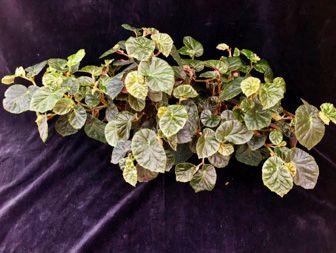
Credit: Julian Ginori, UF/IFAS
Trailing-Scandent
To impress your friends with big, beautiful hanging-basket displays, consider trailing begonias (Figure 5). In their native habitat, these plants can be found climbing trees or filling the gaps in ground cover. They are perfect for placement on top of outdoor walls so that they may cascade downward with a beautiful array of white or pink flowers.

Credit: Julian Ginori, UF/IFAS
Thick-Stemmed
This grouping is difficult to grow well and even harder to find. They usually have one or two upright stems but do not branch naturally (Figure 6). They enjoy plenty of light, but midday sunlight can burn the leaves, making this one of the pickiest groupings of begonia. The thick stem is the showiest aspect of these plants because they tend to lose their lower leaves as they grow, leaving the view of the stems unobstructed.

Rhizomatous Begonias
As the name suggests, these begonias have a rhizome, which is a thickened underground stem that typically grows horizontally, sprouting new sections along the rhizome. This is considered the largest grouping of begonias, with hundreds of species and thousands of cultivars. The majority are fairly compact with round or star-shaped leaves. Due to their short day requirement for flowering, most bloom in the winter with pink or white flowers. They are mainly grown for their colorful foliage. Rhizomatous begonias were originally thought of as indoor plants, but they have recently been used as excellent plants for shady flowerbeds.
Rex Begonias
A personal favorite of many plant collectors, rex begonias include hybrids produced from B. rex and other begonias. All resulting hybrids are grouped under B. × rex-cultorum. Of all the groupings, rex begonias have the most vibrant foliage, coming in all shades of green, red, purple, pink, silver, and brown, and their leaves often have a metallic or iridescent glow (Figures 7 and 8). Foliage comes in many shapes, but most have ear-shaped, star-shaped, or sought-after spiral leaves. Little attention is paid to the pink or white flowers.

Credit: Julian Ginori, UF/IFAS
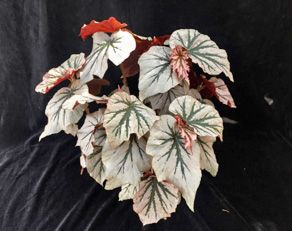
Credit: Julian Ginori, UF/IFAS
Tuberous Begonias
Tubers are similar to rhizomes, but they have some key differences. Tubers are modified stems with starchy interiors, with both roots and shoots growing from the same buds, similar to a potato. Hybrid tuberous begonias include the classic large-flowered begonias used extensively by gardeners. The flowers come in colors ranging from the typical white, red, and pink to the much less common yellow, purple, orange, and more. Flowers are extremely large and are often found in pairs. This grouping includes the hugely popular 'Nonstop®' series of begonia, which is grown worldwide (Figure 9).
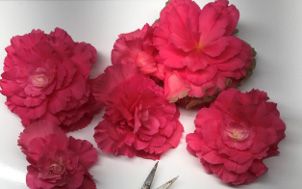
Credit: Matthew Creech, UF/IFAS
Bolivian Begonias
Originating from B. boliviensis and its hybrids, these begonias have recently made a comeback in the market after disappearing for decades (Figure 10). They are known for their enormous tubers and long narrow leaves. Originally a cliff-dwelling species with a trailing habit, the flowers come in shades of orange, red, yellow, pink, and white with long pointed tepals that attract the attention of hummingbirds.
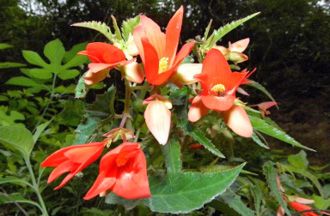
Credit: Patricia M. Ciesla, Forest Health Management International, Bugwood.org
Hiemalis Begonias
The plants that fall into this group originated from the rare winter species B. socotrana. These plants bloom naturally in the winter, yet hybrids that bloom all year long have been produced by subjecting them to artificially short days. The flowers are smaller than other tuberous begonias but are larger than other types of begonias (Figure 11). They come in all colors except blue and usually appear in doubles. They are notoriously difficult to recuperate after a flowering cycle, so most growers simply start new plants every year.
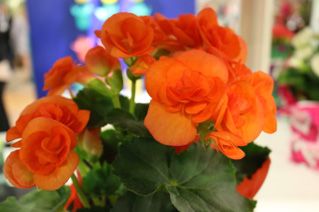
Credit: Matthew Creech, UF/IFAS
Lorraine Begonias
Also known as Christmas begonia (B. × cheimantha), this is a cross between B. socotrana and B. dregei. As with Hiemalis begonias, it is difficult to maintain from year to year (Figure 12). Known for its abundant pink or white flowers, it was aptly named Christmas begonia due to its early-winter blooming period. The first cultivar was named 'Gloire de Lorraine', which is where it gets its common name.
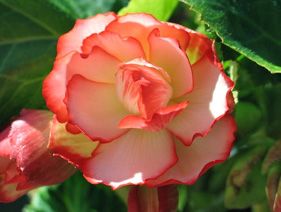
Credit: epiforums (https://www.flickr.com/photos/80228239@N00/234691317), licensed under CC BY-NC-SA 2.0
Semituberous Begonias
This group of begonias resembles small trees, and for this reason, they are commonly grown as bonsai trees even though their stems are not actually woody. They commonly have a swollen stem base (caudex) and small leaves with small, white flowers. The most common species is B. dregei, and all varieties stem from this one species (Figure 13). They should be treated as succulents.
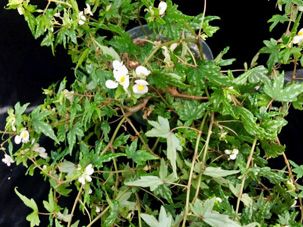
Credit: Julian Ginori, UF/IFAS
For more information about begonias, visit the UF/IFAS Gardening Solutions website.
References
Dewitte, A., A. D. Twyford, D. C. Thomas, C. A Kidner, and J. Van Huylenbroeck. 2011. "The Origin of Diversity in Begonia: Genome Dynamism, Population Processes and Phylogenetic Patterns." In The Dynamical Processes of Biodiversity: Case Studies of Evolution and Spatial Distribution, edited by O. Grillo and G. Venora. London: IntechOpen. doi:10.5772/23789
Doorenbos, J., M. S. M. Sosef, and J. J. F. E. de Wilde. 1998. The Sections of Begonia: Including Descriptions, Keys and Species Lists. Wageningen: Agricultural University.
Hvoslef-Eide, A. K., and C. Munster. 2006. "Begonia: History and Breeding." In Flower Breeding and Genetics: Issues, Challenges and Opportunities for the 21st Century, edited by N. O. Anderson. 241–275. Dordrecht, the Netherlands: Springer.
Neale, S., W. Goodall-Copestake, and C. A. Kidner. 2006. "The Evolution of Diversity in Begonia." In Floriculture, Ornamental and Plant Biotechnology: Advances and Topical Issues, Vol. IV, edited by J. A. Teixeira da Silva. 606-611. Global Science Books.
UF/IFAS Gardening Solutions. 2019. "Begonias." Retrieved from https://gardeningsolutions.ifas.ufl.edu/plants/ornamentals/begonias/